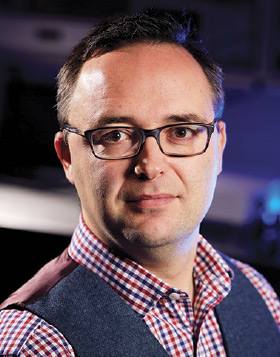CHRISTOPHER G. LEBURN, CHROMACITY
Researchers may soon be able to harness three-photon microscopy to enable new discoveries in regenerative medicine, leukemia, and Alzheimer’s disease, thanks to a new project led by Heriot-Watt University. This imaging technique resolves deep into tissue, where some of the mysteries of debilitating conditions could be unlocked. Researchers are working to develop a platform that is compatible with many laboratory setups already in use.
Multiphoton microscopy can image more deeply into tissue than traditional confocal microscopy, making it ideal for brain studies because it allows imaging of individual synapses and can also be performed in live animals.
Today, the majority of multiphoton imaging research employs two-photon techniques, where fluorescent dyes that emit light upon excitation are used in a specimen. A focused laser beam is used to emit long-wavelength photons, which can excite an electron in the dye to a higher energy state, which can then emit light once two photons are simultaneously absorbed.
The advantage of this technique over single-photon imaging is that it allows generation of two-photon signals in very small volumes, which provides high-resolution images as the laser beam is scanned over a sample. The long wavelengths used to generate two-photon signals also permit cellular imaging deeper into tissue via noninvasive penetration, typically at depths of 500 to
700 µm. The laser industry is focused predominantly on serving the two-photon imaging market with ~100-MHz fixed-wavelength and tunable sources.
In 2013, a seminal piece of research from professor Chris Xu, a Cornell University physicist, demonstrated the capabilities of in vivo three-photon microscopy for the first time, and began to unlock the potential of this modality. In three-photon imaging, three low-energy photons have to be simultaneously absorbed to achieve the excitation of a fluorescent molecule. A longer wavelength is used in the excitation, meaning the light scatters less and enables even deeper penetration into tissue, with imaging possible at depths of greater than 1 mm.
Noninvasive high-resolution imaging of cells at such depths is beneficial, but three-photon imaging is not without its challenges. Currently, the technique has to make use of femtosecond sources that operate with low pulse repetition frequencies (1 to 10 MHz), so that they deliver the high-pulse energies (>250 nJ) required to create the three-photon interaction. These sources operate across the near-infrared spectrum (1200 to 1800 nm) and have to be limited to sub-2-W average power levels to avoid tissue heating that can damage the sample.
The main limitation of three-photon imaging is that there is no ability for resonant imaging, due to the very low repetition rate of the laser. Since a higher density of photons is being used, photodamage and photobleaching are more likely to occur in three-photon imaging than in two-photon imaging.
While some uses of three-photon imaging have been demonstrated in academic institutions, they are not commercial solutions because they are complex and not easily accessible. Three-photon excitation systems based on optical parametric amplifiers (OPAs) are available, but they are highly inefficient and prohibitively expensive for the majority of research facilities. Typically, a high-power (~40-W) pump laser needs to drive a complex, low-repetition-rate, short-pulse oscillator, which then excites a separate amplifier section. Due to the high power requirement, alignment of such systems is not a trivial process. When these elements are combined together, the overall OPA footprint can often be too large for laboratories where space is at a premium.
The Deep Tissue project is a collaboration between Heriot-Watt University, microscopy equipment manufacturer Scientifica, and laser manufacturer Chromacity. The goal is to develop cost-efficient lasers for three-photon microscopy by exploring unique laser system setups and low-megahertz optical parametric oscillators (OPOs), pumped by Chromacity’s ultrafast fiber laser technology.
In contrast to single-pass OPAs, OPOs are four to five times more efficient and can provide shorter pulses with increased wavelength tunability. However, the OPO cavity length usually must match that of its pump laser, limiting outputs to >80 MHz due to space constraints.
The Deep Tissue project aims to create a commercially viable alternative that is compatible with existing microscopy platforms.
There is no doubt that two-photon microscopy will remain a vital tool for bioscience researchers, but the recent growth in published research using three-photon techniques indicates that there is an increasing demand, including from neuroscience and oncology, for the capabilities of this technique for the investigation of serious medical conditions. If three-photon microscopy is to become more widely used, the Deep Tissue project may hold some of the answers for making that happen.
 Meet the author
Meet the author
Christopher G. Leburn, Ph.D., leads commercial growth at ultrafast laser specialist Chromacity, which he co-founded in 2013. The former Royal Society of Edinburgh Enterprise Fellow holds a doctorate from the University of St. Andrews in ultrafast solid-state lasers; email: [email protected].
The views expressed in ‘Biopinion’ are solely those of the author and do not necessarily represent those of Photonics Media. To submit a Biopinion, send a few sentences outlining the proposed topic to [email protected]. Accepted submissions will be reviewed and edited for clarity, accuracy, length, and conformity to Photonics Media style.